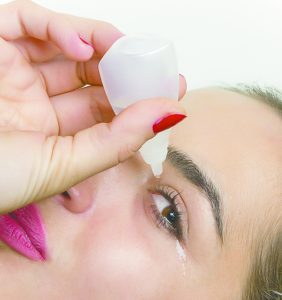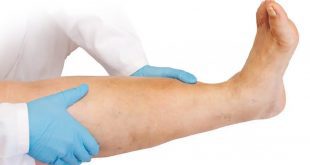By Anne-Marie Chalmers, MD
 Increasing our intake of omega-3 from fish and cod liver oil can be an effective and relatively inexpensive way to help manage dry eye symptoms. Most articles addressing dry eyes mention omega-3 supplements for their anti-inflammatory benefits. And many ophthalmologists and optometrists recommend taking them.
Increasing our intake of omega-3 from fish and cod liver oil can be an effective and relatively inexpensive way to help manage dry eye symptoms. Most articles addressing dry eyes mention omega-3 supplements for their anti-inflammatory benefits. And many ophthalmologists and optometrists recommend taking them.
There’s good reason for all the omega-3 excitement. Most dry eye issues appear to be caused by Meibomian Gland Dysfunction (MGD). With MGD, the protective oil in our tears gets blocked from coming to the surface of the eye, causing our tears to evaporate too quickly. Omega-3 fatty acids, which are found plentifully in fish and cod liver oil, are helpful for two reasons: 1) they relieve chronic inflammation, which is both a symptom and a cause of MGD, and 2) they improve the quality of the oil in our tears.
If you are starting an omega-3 regimen for dry eyes, however, it’s important to set yourself up for success by doing the following:
1. Get an effective dose.
For any omega-3 supplement to be effective, it is important to consume an adequate dose. Most research done on omega-3 and dry eyes have utilized at least two fish oil capsules a day.
Looking at the broader scope of omega-3 research, however, there’s reason to believe that we need more than two capsules to help combat chronic inflammation symptoms. Numerous reviews suggest the anti-inflammatory effects of omega-3 don’t kick in unless you get more than 2700 mg of EPA/DHA daily. That’s the same as consuming 8-10 regular fish oil capsules or taking one tablespoon of liquid cod liver oil every day.
2. Practice consistency.
To experience benefits, it is necessary to take your omega-3 supplement daily. Because omega-3 is an important part of the cell’s metabolism, the body needs a regular supply of the fatty acids to combat chronic inflammation. With dry eyes, regularly consuming omega-3 will in additional help maintain the lipid balance of the oil in the tear film.
If you have trouble remembering to take your daily dose, try taking your supplement in conjunction with a meal or set a daily reminder alarm. The key is to stick with it.
3. Give it time.
Although increasing your intake of omega-3 can be a wonderful way to improve dry eye symptoms, it’s not a quick fix. Most studies showing benefits of omega-3 supplementation for dry eyes last at least 3 months. That’s because it takes time for the omega-3 supply to build up in the body.
With Omega Cure® Extra Strength, customers typically report noticing a difference for dry eye symptoms within 6 to 8 weeks if they are diligent about taking their daily dose. However, be aware that the effects will vary from one individual to the next.
4. Get a fresh fish oil.
Getting enough omega-3 fatty acids is crucial for our health. The omega-3 molecules make up part of the cell membrane. They play an important role both in the exchange of nutrients across the cell membrane and in fighting inflammation. However, omega-3 fatty acids have a molecular structure that make them extremely prone to oxidation — or in layman’s terms — spoiling.
When the omega-3 molecules oxidize, they give off a fishy taste and smell. Studies from Norway, New Zealand and Canada have found that a high percentage of omega-3 supplements are rancid. In addition, scientists not only suggest rancid omega-3 products are less potent than fresh ones; they now warn that consuming rancid fish oil may contribute to problems like Alzheimer’s disease, cell mutation, and clogged arteries.
To make sure you are getting a fresh product, use your senses. If you are taking a liquid product, taste and smell the oil. If it is fresh, it shouldn’t have much taste or smell at all. The same goes for capsules. Break open your capsules to assess the contents.
5. Take it in the morning.
If you are having problems sleeping due to dry eye pain, you may want to take your omega-3 supplement in the evening a couple of hours before bed. However, if you are like many people with dry eyes, your symptoms get worse as the day progresses. To get the most relief from your omega-3 product, try taking it in the morning with a meal.
If you are religious about taking your omega-3, what happens then? Studies indicate that omega-3 supplementation can improve the measurements used to evaluate dry eyes. These include improved tear osmolarity, decreased tear evaporation rate and relief in dry eye discomfort. Patients in these studies have also self-reported improvements in eye redness and blurry vision. In addition, studies show that people with higher intakes of omega-3 fatty acids have a lower risk of getting dry eyes.
About Anne-Marie Chalmers, MD
Anne-Marie Chalmers, MD, is the co-founder and president of Omega3 Innovations. Born and raised in the United States, Dr. Chalmers graduated from Brown University and completed her medical training at the University of Oslo in Norway. In Norway, Dr. Chalmers practiced emergency, family, and preventive medicine for many years. Her research and development work has included nutraceuticals (especially omega-3) and medical delivery device systems to facilitate ingestion of multiple medication combinations.
Omega 3
Call us at 941-485-4400
www.omega3innovations.com
Check Also
Obstructive Sleep Apnea & Oral Appliances: A Solution for a Good Night’s Sleep
By Richard W. Rozensky, DDS, D.ABDSM Sleep apnea affects more than 25 million people in …
 Central Florida Health and Wellness Magazine Health and Wellness Articles of the Villages
Central Florida Health and Wellness Magazine Health and Wellness Articles of the Villages



